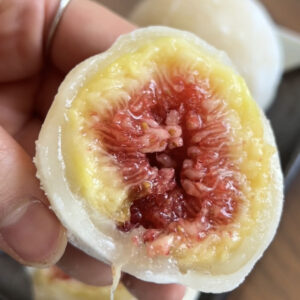
Fruit daifuku (fruit and anko wrapped in a thin mochi) might be the easiest but most decadent-looking dessert ever! Something about wrapping the fruit up in the soft and pillowy mochi is almost therapeutic.
Fig season might be my favorite because it means I get to make these fig daifuku mochi! While I was writing up this recipe, I was learning all about figs and how nutritious they are: they are a prebiotic which means it will eventually become a food source for your good gut bacteria, plus they contain a digestive enzyme called ficin. THIS is what I thought was SO cool!
The digestive enzyme is a protease enzyme which means it helps digest protein and turns it into amino acids. In this case, the digestive enzyme in figs helps break down the protein in the shiro-an — just naturally! FOOD IS SO COOL!!
I have been studying to get my food fermentation specialist license and would love to share more about the things I’m learning and food science if people are interested so let me know if this stuff interests you too 😉
Anyways, back to this fig daifuku.
Fruit daifuku is actually quite expensive in Japan, so here is my recipe for those who want to make it at home — OR if you don’t have easy access to daifuku where you live!
All you need is a microwave and a little bit of patience and you’re ready to make these adorable fig daifuku 🙂
SHIRO-AN: This sweetened white bean paste can be purchased online or you can also make it from scratch! I love using this recipe, but you can also use regular adzuki bean paste anko if it’s too hard to find shiro-an.
FIG: I recommend peeling your fig before wrapping it in shiro-an for a better texture when you bite into the mochi. When wrapping the anko, I like to spread a thin layer of shiro-an onto a piece of plastic wrap before placing the fig in the middle and folding up the sides (watch my video on Instagram if you want to see the step by step process). This helps the shiro-an not stick to your hands and it also helps to form it into a smooth circle.
MOCHI: Mochi is traditionally made by pounding freshly cooked sweet rice flour, but when making the thin mochi for a fruit daifuku, all you need is to heat “shiratamako” or glutinous rice flour, sugar and water.
I hope you get to try making these figs daifuku! I also love making this daifuku using different fruit like strawberries, mango, kiwi, too!
As always, tag me on social @takahahsheats if you make them and let me know if you have any questions 🙂 Itadakimas! <3

Hello! This looks so delicious, can’t wait to try. Thank you for sharing. I don’t have microwave, I assume it’s ok to heat on the stovetop?
Hi Christine! Thanks for asking — yes, you can make the mochi on your stovetop! I would make sure you keep mixing the mochi mixture because it will get thick pretty quickly. I recommend using a heat safe spatula because I’ve tried it with a wooden spatula and it was suuuuper sticky. Let me know if you have any other questions!